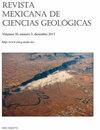Sewage sludge from Taxco de Alarcón wastewater treatment plant as substrate to cultivate Panicum maximum
IF 0.5
4区 地球科学
Q4 GEOSCIENCES, MULTIDISCIPLINARY
Revista Mexicana De Ciencias Geologicas
Pub Date : 2021-11-24
DOI:10.22201/cgeo.20072902e.2021.3.1617
引用次数: 2
Abstract
The management and disposal of the sewage sludge (SS) generated by a wastewater treatment plant (WWTP) as part of the municipal wastewater (MWW) treatment process is one of the main socio-environmental issues faced by this type of system. Taxco de Alarcón, Guerrero, in southern Mexico has had a WWTP operating since 2016, and the SS disposal is a task that must be addressed by the WWTP. Thus, the aim of this work was to evaluate the growth capacity of Panicum maximum, also known as mombaza grass (MG), by using SS generated within the "Taxco de Alarcón wastewater treatment plant" as substrate. To do so, 4 g of MG seeds were scattered over 5 kg (dry basis) of SS. As a control, a commercial compost soil was used, hereafter called pattern soil (PS). The experiment was carried out in triplicates for three months and drinking water (water used for human consumption) was used for crop irrigation. Each month a MG harvest was carried out. The response variables analyzed for MG were germination time (one month after plant emergence), height (HMG), growth rate GrMG, and yield (YMG), whereas in the SS and PS the content of organic matter was analyzed. Furthermore, the chemical composition was analyzed using scanning electron microscopy and X-ray energy dispersion spectroscopy (SEM-EDS) on the MG, SS, and PS. The results showed that MG germinated faster on PS (5 days) than germination on SS (7 days). However, the MG grown on SS reached a considerably higher height (45 cm) compared to the height reached on PS (17 cm). Furthermore, the maximum GrMG over SS was also higher than the maximum GrMG observed on the PS, 3.64 and 1.40 cm∙day-1, respectively. In terms of YMG, it was observed that on SS it reached an average monthly YMG of 416 g∙m-2, whereas in PS it reached a YMG of 72 g∙m-2. The chemical analysis detected P, K, Ca, Mg, and S, considered macronutrients in both substrates. Besides, some micronutrients identified in SS were Cu, Fe, Mn, and Zn, whereas in PS it was also possible to detect micronutrients except Mn and Zn. All the macronutrients detected in the substrates were observed in the harvested MG. However, in the MG harvested in PS, Mn and Zn were not detected. Hence, a feasible disposal strategy for the SS generated by the Taxco de Alarcón WWTP is as a substrate for grass forage MG by its high organic matter content, the significant presence of macro and micronutrients, and the performance shown by MG cultivated in SS. Furthermore, the SS characteristics provide added value and can be considered as organic amendments of agricultural soils.Taxco de Alarcón污水处理厂的污泥作为培养最大圆锥花序的基质
作为城市污水(MWW)处理过程的一部分,污水处理厂(WWTP)产生的污泥(SS)的管理和处置是此类系统面临的主要社会环境问题之一。墨西哥南部格雷罗州的Taxco de Alarcón自2016年以来一直有一个污水处理厂在运营,SS处理是污水处理厂必须解决的任务。因此,本工作的目的是通过使用“Taxco de Alarcón废水处理厂”内产生的SS作为基质,评估Panicum maximum(也称为mombaza草(MG))的生长能力。为此,将4g MG种子撒在5kg(干基)SS上。作为对照,使用了一种商业堆肥土壤,下文称为模式土壤(PS)。实验分三次进行,为期三个月,饮用水(人类饮用水)用于作物灌溉。每个月进行一次MG收割。MG分析的反应变量是发芽时间(植物出苗后一个月)、高度(HMG)、生长速率GrMG和产量(YMG),而SS和PS分析的是有机质含量。此外,使用扫描电子显微镜和X射线能量分散光谱(SEM-EDS)对MG、SS和PS的化学成分进行了分析。结果表明,MG在PS上(5天)发芽快于在SS上(7天)发芽。然而,与在PS上达到的高度(17cm)相比,在SS上生长的MG达到了相当高的高度(45cm)。此外,SS上的最大GrMG也高于PS上观察到的最大GrMG,分别为3.64和1.40 cm∙day-1。就YMG而言,据观察,SS的月平均YMG为416 g∙m-2,而PS的月平均YMG为72 g∙m-1。化学分析检测到P、K、Ca、Mg和S,它们被认为是两种基质中的常量营养素。此外,在SS中鉴定出的一些微量营养素是Cu、Fe、Mn和Zn,而在PS中也可以检测出除Mn和Zn之外的微量营养素。基质中检测到的所有常量营养素都在收获的MG中观察到。然而,在PS中收获的MG没有检测到Mn和Zn。因此,Taxco de Alarcón污水处理厂产生的SS的一种可行的处理策略是将其作为草料MG的基质,因为其有机质含量高,大量存在微量营养素和微量营养素,以及在SS中培养的MG表现出的性能。此外,SS特性提供了附加值,可以被视为农业土壤的有机改良剂。
本文章由计算机程序翻译,如有差异,请以英文原文为准。
求助全文
约1分钟内获得全文
求助全文
来源期刊

Revista Mexicana De Ciencias Geologicas
地学-地球科学综合
CiteScore
1.00
自引率
12.50%
发文量
0
审稿时长
6-12 weeks
期刊介绍:
Revista Mexicana de Ciencias Geológicas (RMCG) publishes original research papers on geological processes of broad interest, and particularly those dealing with regions of Latin America. The RMCG also publishes review papers on topics of current interest, and on the geology and tectonics of geological provinces of Latin America. Besides, it offers the opportunity for host editors to publish special thematic issues.
 求助内容:
求助内容: 应助结果提醒方式:
应助结果提醒方式:


